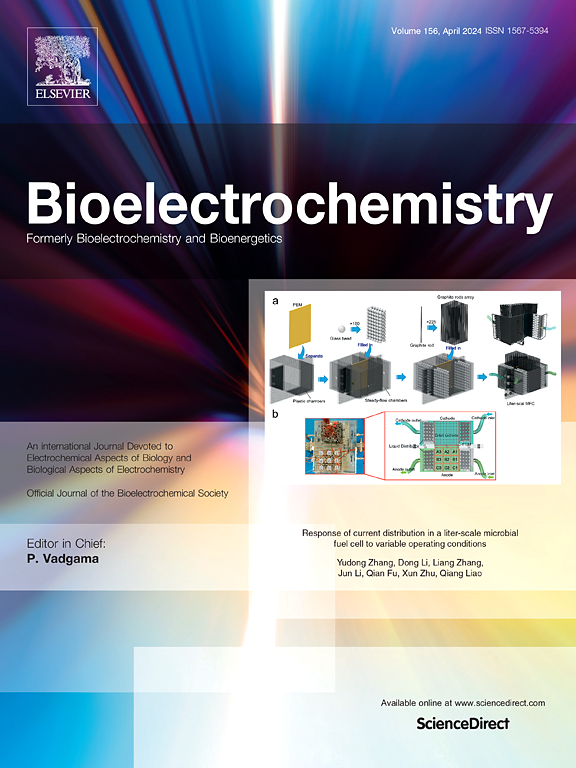Platinum–zinc oxide as a super signal amplifier for ultrasensitive electrochemical immunodetection of CEA
IF 4.5
2区 化学
Q1 BIOCHEMISTRY & MOLECULAR BIOLOGY
引用次数: 0
Abstract
Electrochemical immunosensors are essential for disease screening, diagnosis, treatment and monitoring. In this study, a novel sandwich-type electrochemical immunosensor has been constructed for the sensitive detection of tumor marker carcinoembryonic antigen (CEA) based on platinum‑zinc oxide (Pt-ZnO) nanoparticles as a signal amplification platform. Pt-ZnO has outstanding peroxidase-like activity that enables efficient catalysis of the H2O2 reaction, leading to effective amplification of the current signal through numerous electron transfers. Its high specific surface area and excellent dispersion allow for immobilization with secondary antibodies through the Pt![]() N bond. Moreover, graphene quantum dots–chitosan possesses outstanding electrical conductivity and biocompatibility, enabling it to improve interfacial electron transfer and capture more primary antibodies on its surface. The Pt-ZnO signal amplification system has achieved a wide linear range for the CEA detection, which spanned from 10 fg mL−1 to 100 ng mL−1 with the limit of detection (LOD) of 1.02 fg mL−1. The LOD of the electrochemical immunosensor was seven orders of magnitude lower than that of the traditional enzyme-linked immunosorbent assay. Furthermore, it has viable reproducibility, stability and practicality. Hence the Pt-ZnO electrochemical immunosensor has great potential for the clinical identification of CEA.
N bond. Moreover, graphene quantum dots–chitosan possesses outstanding electrical conductivity and biocompatibility, enabling it to improve interfacial electron transfer and capture more primary antibodies on its surface. The Pt-ZnO signal amplification system has achieved a wide linear range for the CEA detection, which spanned from 10 fg mL−1 to 100 ng mL−1 with the limit of detection (LOD) of 1.02 fg mL−1. The LOD of the electrochemical immunosensor was seven orders of magnitude lower than that of the traditional enzyme-linked immunosorbent assay. Furthermore, it has viable reproducibility, stability and practicality. Hence the Pt-ZnO electrochemical immunosensor has great potential for the clinical identification of CEA.
铂氧化锌作为超信号放大器用于CEA的超灵敏电化学免疫检测
电化学免疫传感器对疾病的筛查、诊断、治疗和监测至关重要。本研究基于铂氧化锌纳米粒子作为信号放大平台,构建了一种新型的三明治型电化学免疫传感器,用于肿瘤标志物癌胚抗原(CEA)的灵敏检测。Pt-ZnO具有出色的过氧化物酶样活性,能够有效催化H2O2反应,通过大量电子转移有效放大电流信号。它的高比表面积和良好的分散性允许通过PtN键与二抗固定。此外,石墨烯量子点-壳聚糖具有优异的导电性和生物相容性,使其能够改善界面电子转移并在其表面捕获更多的一抗。Pt-ZnO信号放大系统对CEA的检测具有较宽的线性范围,从10 fg mL−1到100 ng mL−1,检测限(LOD)为1.02 fg mL−1。电化学免疫传感器的LOD比传统酶联免疫吸附法低7个数量级。具有良好的再现性、稳定性和实用性。因此,Pt-ZnO电化学免疫传感器在CEA的临床鉴定中具有很大的应用潜力。
本文章由计算机程序翻译,如有差异,请以英文原文为准。
求助全文
约1分钟内获得全文
求助全文
来源期刊

Bioelectrochemistry
生物-电化学
CiteScore
9.10
自引率
6.00%
发文量
238
审稿时长
38 days
期刊介绍:
An International Journal Devoted to Electrochemical Aspects of Biology and Biological Aspects of Electrochemistry
Bioelectrochemistry is an international journal devoted to electrochemical principles in biology and biological aspects of electrochemistry. It publishes experimental and theoretical papers dealing with the electrochemical aspects of:
• Electrified interfaces (electric double layers, adsorption, electron transfer, protein electrochemistry, basic principles of biosensors, biosensor interfaces and bio-nanosensor design and construction.
• Electric and magnetic field effects (field-dependent processes, field interactions with molecules, intramolecular field effects, sensory systems for electric and magnetic fields, molecular and cellular mechanisms)
• Bioenergetics and signal transduction (energy conversion, photosynthetic and visual membranes)
• Biomembranes and model membranes (thermodynamics and mechanics, membrane transport, electroporation, fusion and insertion)
• Electrochemical applications in medicine and biotechnology (drug delivery and gene transfer to cells and tissues, iontophoresis, skin electroporation, injury and repair).
• Organization and use of arrays in-vitro and in-vivo, including as part of feedback control.
• Electrochemical interrogation of biofilms as generated by microorganisms and tissue reaction associated with medical implants.
 求助内容:
求助内容: 应助结果提醒方式:
应助结果提醒方式:


